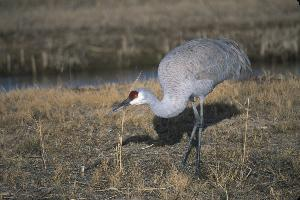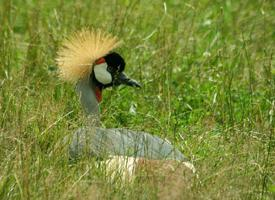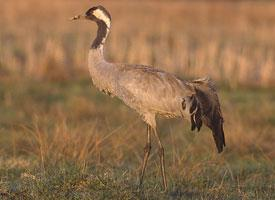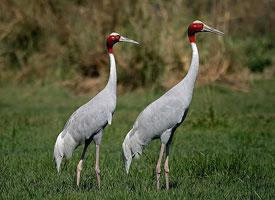
Váhy a míry
| Délka | od 80 do 120 cm |
|---|---|
| Hmotnost | od 3 do 6,5 kg |
Biologická data
| Délka života | od 2 do 20 let |
|---|
Popis zvířete
The Sandhill Crane (Antigone canadensis) is a majestic, tall bird that is native to North America and parts of Siberia. This species is one of the most ancient living birds, belonging to the family Gruidae, and has existed in its current form for several million years. Its elegance and distinctive calls make it a symbol of wilderness and an important figure in various cultural folklore and mythology.Adult Sandhill Cranes are identifiable by their large size, standing up to 4-5 feet tall, with a wingspan that can reach 6-7 feet across, making them one of the largest birds in North America. Their bodies are covered in gray feathers, which can sometimes appear reddish-brown due to mud that the cranes preen into their feathers. One of the most striking features of the Sandhill Crane is its bright red forehead, white cheeks, and long, dark bill. They possess long, black legs that trail behind them in flight and are used to wade through water in search of food.
Sandhill Cranes are highly social birds, often found in large flocks, especially during migration. They are known for their spectacular courtship dances, which include jumping high in the air, flapping their wings, and calling to each other in a display that strengthens bonds between mates. These birds mate for life, which can be several decades, and both parents share in the duties of raising their young.
Their diet is omnivorous, consisting of plant material, grains, small mammals, amphibians, and invertebrates. They forage in shallow waters or fields, using their long bills to probe for food. During migration and winter, they can often be found in agricultural fields, feeding on leftover grains and crop seeds.
The Sandhill Crane's call is a loud, rolling, trumpeting sound that can carry for several kilometers, serving as a means of communication between individuals and flocks. These calls play a crucial role during migration, breeding, and in maintaining the social structure of the flock.
Sandhill Cranes undertake one of the most impressive migrations of any North American bird. There are several migratory populations, with some traveling from as far north as Siberia and Alaska to as far south as Mexico and the Gulf Coast of the United States. The Platte River in Nebraska is one of the most famous staging areas for these migrations, where hundreds of thousands of cranes gather each spring to rest and feed before continuing north to their breeding grounds.
Conservation efforts have been largely successful in protecting Sandhill Crane populations, which have rebounded from low numbers in the past. However, habitat loss and degradation remain threats, particularly in their breeding and wintering grounds. Wetland preservation is crucial for the survival of these birds, as these habitats are essential for feeding, nesting, and breeding.
In conclusion, the Sandhill Crane is a remarkable bird that plays an important role in the ecosystems it inhabits. Its presence is a testament to the health of wetland habitats across North America. With their graceful demeanor, complex behaviors, and incredible migrations, Sandhill Cranes continue to captivate and inspire bird watchers, conservationists, and nature enthusiasts around the world.
Podobná zvířata
Nové fotografie zvířat
Top 10 zvířat
- Chinese water dragon (Physignathus cocincinus)
- Galápagos tortoise (Geochelone nigra complex)
- Dolphin gull (Leucophaeus scoresbii)
- Japanese macaque (Macaca fuscata)
- Colombian red howler (Alouatta seniculus)
- Sea urchins (Echinoidea)
- Moustached guenon (Cercopithecus cephus)
- Diana monkey (Cercopithecus diana)
- Common reed warbler (Acrocephalus scirpaceus)
- Common house mosquito (Culex pipiens)


